 |
||
|
||
| ||
DDR memory is no more exotic on platforms designed for AMD processors. Its price is already comparable to that of the SDRAM. Besides, there are a lot of chipsets intended for it and board makers cope excellently with this platform. There are more and more models available on the market. The AMD760 and VIA KT266 chipsets which support the DDR SDRAM have already gained solid ground; the latter has even reached the "A" version. However, apart from middle and high priced systems there is also a budget PC market with its lack for DDR. Neither KT266(A) nor AMD760 are related to it: solutions on these chipsets are no more expensive, but they are not cheap enough as well. Besides, if a user gets a motherboard on such a chipset he intends to use its potential right now, not tomorrow. It means that such a system must be equipped with a upper model of the ADM Athlon processor because at less than 1 GHz the fast memory won't perform better than a usual SDRAM PC133 as a slow CPU won't be able to process all data from memory on time. But what if a user can't afford a processor with a high frequency and a motherboard much higher than a budget one and, at the same time, has no desire to do with an outdated SDRAM PC133? Well, there is the SiS735 chipset. Today you can install an inexpensive Athlon/Duron and tomorrow you will be able to replace it with a more efficient model. Moreover, this chipset supports both memory types - DDR SDRAM and SDRAM PC133. At the same time, it is cheap enough and has enough power to outscore its competitors. Unfortunately, until recently this chipset wasn't paid due attention to. It is very easy, you know, to lose reputation, and it is quite difficult to gain it back. Luckily, the situation is gradually changing, and some manufacturers have announced their products on the SiS735. Today we will take a look at two products - Elpina M830LR and MSI K735 Pro and compare it with the Chaintech 7SID. Boards' specifications
Chaintech 7SID The board we have received is a pre-production sample, but it scored very good results. In the box one can find ATA66/100 and FDD cables, a scanned sheet of paper with functions of switches and positions of different connectors and a CD-R disc with a good installer instead of just a set of drivers. The site of the company says that the board will ship together with a "Value Pack 2000" disc with freeware programs. 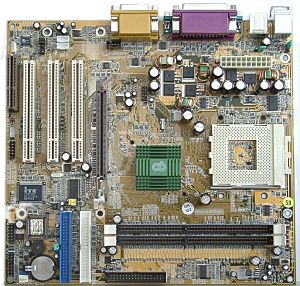 This little board has a typical set of components. Apart from an integrated sound controller with a connector on a front panel with audio-outs there is a smart-card reader connector. In all other respects, it is a usual board. It is equipped with 11 2200 uF capacitors and a little set of switches. One is used to set a frequency of the CPU or memory - 100/100, 100/133 and 133/133 MHz, another allows us to turn on the computer with a PS/2 mouse or keyboard, and the third will help us clear the CMOS contents. The BIOS is based on v6.00 from AWARD and has a lot of settings: you may adjust memory settings, improve the performance of the AGP bus, manually distribute interrupts among PCI slots. As far as processor overclocking is concerned, there is nothing you can do about it. Despite its disadvantages, the board will work excellently in a high-efficient home computer. Elpina M830LR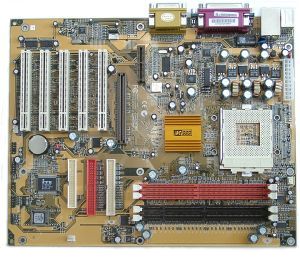 Elpina is a trademark of a famous manufacturer of inexpensive motherboards - PC-CHIPS. This giant is a serious competitor against Asustek, MSI and Gigabyte, though they play in different market sectors. The board was received in an OEM package. It came with ATA66/100 and FDD cables, a scarce user's manual and a CD with drivers and free software. An AMR modem was optional, and in our case it was absent. Apart from drivers the CD contained WinDVD, MediaRing Talk and PC-Cillin 2000. This board is the first in our lab which has two DIMM connectors - for DDR and for SDR SDRAM. Besides, it is equipped with integrated network and audio controllers. The layout of the board is not very convenient: IDE and FDD connectors are located right behind PCI slots, while audio-ins are right in front of them. The board has ten 2200uF capacitors which makes it highly stable. There is also a connector which allows putting audio-outs onto the front panel, and a connector for network controller LEDs. The BIOS is based on the AMI BIOS and the number of parameters is not striking. Thus, you can choose a latency for the memory - 2, 2.5, 3; all other timing settings are hidden behind Safe, Normal, Fast and Ultra modes. The AGP mode can installed as 1x, 2x or 4x. The FSB and memory frequency can be set at 100 or 133 MHz. We do not back testing of noname products which often fail to meet requirements of reliability and operating speed. But since there are not many SiS 735 based boards available on the market we decided to test this sample. It is not a secret that products from this company were often blamed. But this board has an attractive price - $70 and performed quite well in the tests. MSI K735 Pro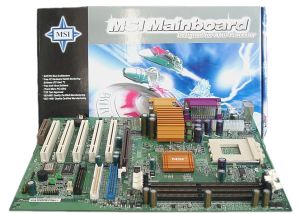 This board is a production sample and, therefore, comes with a detailed user's manual, ATA66/100 and FDD cables, a booklet with description of a D-LED function, a sticker with the logo and a CD. The latter contains drivers for motherboards, video cards and other products from MSI, descriptions of all MSI boards in .pdf format, and such interesting programs as Adobe Acrobat Reader, AMI and Award utilities for operation with Suspend-To-Disk function and WinFlash from Award for updating BIOS from the Windows. Moreover, there are some MSI proprietary programs - LiveBIOS and Fuzzy Logic 3, and PC Alert, a utility which controls temperatures and fan speeds and implements some other functions. The GoodMem utility will help you remove unnecessary programs from the memory. The MediaRing Talk is meant for online talks, X-Setup is able to set the majority of Windows parameters, PCCillin 2000 is a good antivirus packet, 3Deep helps to adjust color balance and VNC is intended for computer remote access. The board is equipped with one heatsink on the chipset and another, quite massive, on the CPU feed circuit elements. Usually there are several small heatsinks on each element. Why the developers used this one is unclear as the core voltage is not higher than the rated one. The pulse converters contain 8 LowESR capacitors - 3 of 1800uF and 6 of 2200uF. 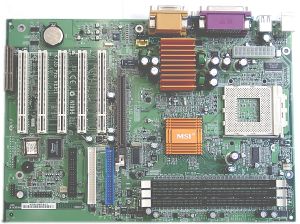 The D-LED technology traces the POST procedure processing with 4 LEDs, and although it is not so convenient as 7-segment indicators you can find it on almost all MSI boards. The layout is not ideal: IDE and FDD connectors are located right behind PCI and AGP slots. The former ones with be difficult to reach if extension cards are inserted into the slots. There are only two switches - to clear the CMOS and to enable/disable audio codec. The BIOS is based on the v6.00 from AWARD and offers memory and AGP bus settings, and a manual distribution of interrupts among PCI slots. Overclockers can change a FSB frequency (100, 103, 107, 110, 112, 124, 133, 137, 143, 147 and 150MHz), a CPU multiplier and core voltage (from 1.3 to 1.85V in 0.025V steps). Besides, for core voltage there are two mode modes: default and No CPU. The latter remained mysterious as the board hung in course of testing memory modules. During the tests the board had no bugs either in operation or in installation. This model is currently one of the best for Athlon processors. Test system configuration and test softwareTest stand:
Software:
Since the Elpina M830LR supports both SDRAM PC133 and DDR SDRAM, we decided to estimate its performance with both memory types. Performance 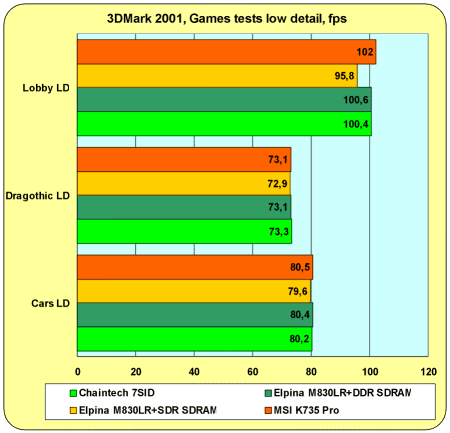 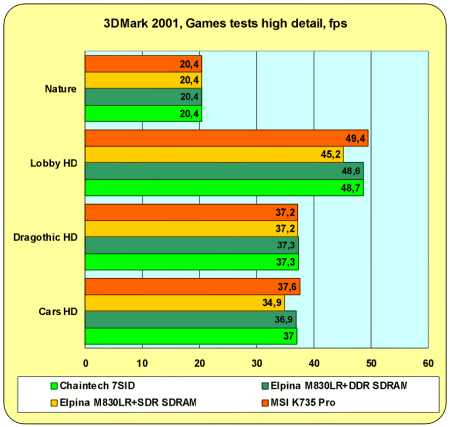 The MSI K735 Pro is of course a leader. The Elpina M830LR and Chaintech 7SID go on a par. The Elpina M830LR+SDRAM system is undoubtedly the last. 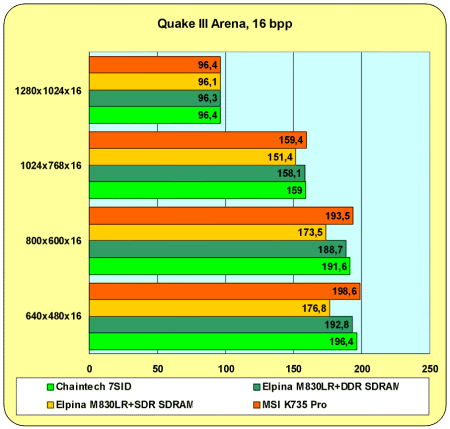  The only difference from the situation above is that the Chaintech nudges out the Elpina. The Elpina is an absolute outsider, and only starting from 1024X768 the Chaintech 7SID "joins" it. 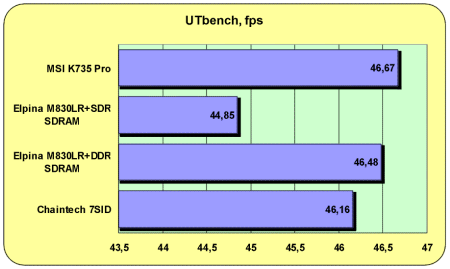 Here everything is absolutely clear: all DDR based boards have an equal performance, with the SDRAM PC133 falling behind them. 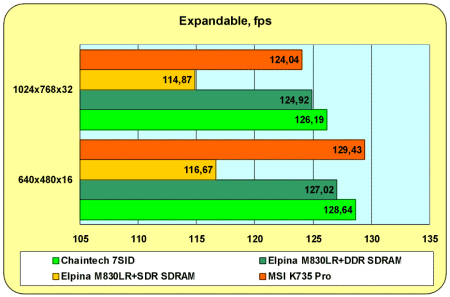 In low resolutions the Elpina M830LR+DDR SDRAM has unexpectedly caught up with the leader MSI K735 Pro, and even outdone it in high resolutions while lagging behind the Chaintech 7SID! It seems that it is the specific timing settings in the BIOS of the Elpina and Chaintech boards that allowed them to outperform the MSI.  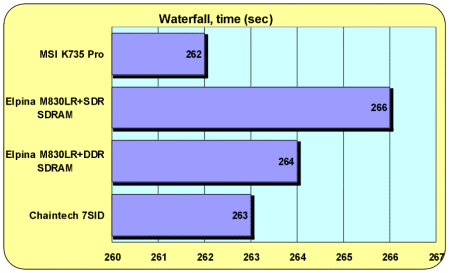 It might seem strange that we tested the value motherboards with serious graphics applications and professional OpenGL programs. But I think that upper Athlon models coupled with DDR memory are some kind of semiprofessional systems. In the 3DStudio MAX the MSI K735 Pro again comes out a winner and the Elpina M830LR+DDR RAM is again the last among DDR based systems. But the difference is so small that you will hardly notice it in reality. In the SPEC Viewperf the MSI is still shining, while the Chaintech and Elpina go on a par.  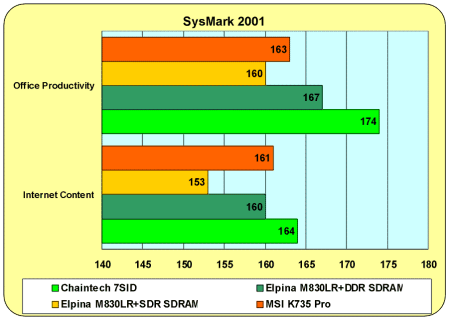 Now comes the most interesting - office applications. The Chaintech 7SID looks like the best choice here. While in the ZD Winstone 2001 it shares the first place with the Elpina M830LR, in the SYS Mark 2001 it sweeps the field. ConclusionIf you want a faster and more expensive board - take the MSI K735 Pro, if you prefer a cheaper one and mainly for office work - go with the Elpina M830LR+DDR. The cheapest alternative is the Elpina M830LR+SDRAM PC133, which can, though, be coupled with DDR in future. The most elegant, modern and compact solution is the Chaintech 7SID. It can recommended instead of the Elpina + DDR SDRAM, but mind the form-factor. If it doesn't matter for you, then the Chaintech 7SID will be an excellent purchase. Well, even such inexpensive boards on such an inexpensive
chipset are divided into fields of application. And this is very
good as you will easily find the board you need.
Write a comment below. No registration needed!
|
Platform · Video · Multimedia · Mobile · Other || About us & Privacy policy · Twitter · Facebook Copyright © Byrds Research & Publishing, Ltd., 1997–2011. All rights reserved. | |||||||||||||||||||||||||||||||||||||||||||||||||||||||||||||||||||||||||||||||||||||||||||||||